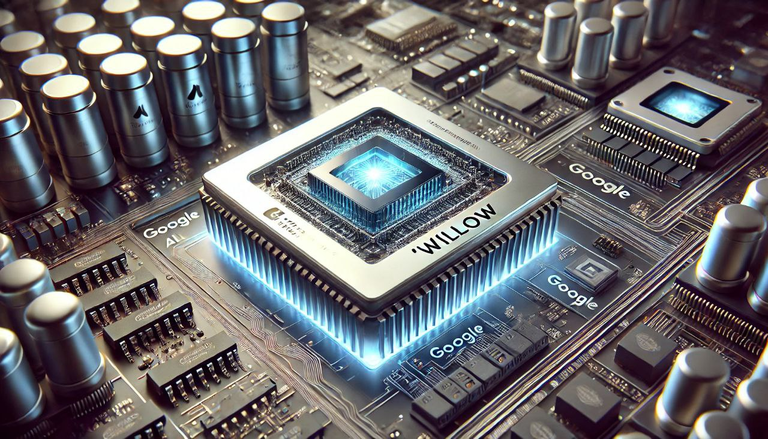Google Unveils New Quantum Computing Chip "Willow"
KEY FACT: Google's Quantum AI team has unveiled a groundbreaking quantum computing chip called Willow, which features 105 qubits and achieves an exponential reduction in error rates, in order to make in quantum computers stable and practical. The chip can solve problems in under five minutes that would take conventional supercomputers billions of years, though it is still far from the 13 million qubits needed to pose a real threat to cryptographic systems like Bitcoin. Despite this, the rapid advancements exposes the urgency for post-quantum cryptography to safeguard digital systems. Google CEO Sundar Pichai emphasized the chip’s potential for real-world applications such as drug discovery and energy solutions, while experts in blockchain and technology continue exploring ways to preemptively address future quantum-related challenges.

Source: Quantum AI
Google Unveils New Quantum Computing Chip "Willow"
Google's Quantum AI team has announced an advancement in quantum computing with the development of their latest chip, known as "Willow". This new processor reportedly solves complex computational problems in under five minutes—tasks that would take current supercomputers an unfathomable 10 septillion years to complete.
Today I’m delighted to announce Willow, our latest quantum chip. Willow has state-of-the-art performance across a number of metrics, enabling two major achievements. The first is that Willow can reduce errors exponentially as we scale up using more qubits. This cracks a key challenge in quantum error correction that the field has pursued for almost 30 years. Second, Willow performed a standard benchmark computation in under five minutes that would take one of today’s fastest supercomputers 10 septillion (that is, 1025) years — a number that vastly exceeds the age of the Universe. Source
The Willow chip comprises 105 qubits, the fundamental units of quantum information. A notable feature of Willow is its ability to exponentially reduce error rates as the number of qubits increases, addressing a longstanding challenge in quantum error correction that experts have grappled with for nearly three decades.
Hartmut Neven, head of Google's Quantum AI division, has emphasized the significance of this breakthrough, stating that the team has achieved an exponential reduction in error rates, a milestone referred to in the field as "below threshold." This means that as more qubits are added, the system becomes more stable and less prone to errors, a critical step toward building practical, large-scale quantum computers.
Google CEO Sundar Pichai hypes Willow as a significant step in the company's quest to develop a useful quantum computer with real-world applications, including drug discovery, fusion energy, and battery design. Despite this progress, Google's quantum computing roadmap indicates that the company has reached only the second of six milestones, underscoring that significant work remains ahead.
The rapid advancements in quantum computing have raised concerns about the potential threat to current cryptographic systems, particularly in the cryptocurrency industry. Quantum computers are capable of breaking existing encryption protocols and could expose user funds to theft on an unprecedented scale. However, experts assert that such threats remain distant. Kevin Rose, a tech entrepreneur and former senior product manager at Google, noted that compromising Bitcoin's encryption would require a quantum computer with approximately 13 million qubits. In contrast, Willow comprises 105 qubits, indicating that while the advancement is remarkable, it is still far from posing a real threat to crypto encryption.
David Marcus, CEO of payment platform Lightspark, remarked on the implications of Google's breakthrough, suggesting that it reveals the need for accelerated development in post-quantum cryptography and encryption to safeguard against future quantum capabilities.
In response to potential quantum threats, Ethereum co-founder Vitalik Buterin has proposed proactive measures. He suggested that a simple hard fork could mitigate risks posed by quantum computing to the Ethereum network, indicating that the blockchain community is actively seeking solutions to stay ahead of technological advancements.
Google's unveiling of the Willow chip, brings the promise of unprecedented computational power closer to reality. While the implications for various industries are profound, the current state of technology suggests that existing cryptographic systems remain secure for the foreseeable future. Nonetheless, this development serves as a catalyst for ongoing research and innovation in both quantum computing and cryptography to prepare for the challenges and opportunities that lie ahead.

If you found the article interesting or helpful, please hit the upvote button, and share for visibility to other hive friends to see. More importantly, drop a comment below. Thank you!
This post was created via INLEO, What is INLEO?
INLEO's mission is to build a sustainable creator economy that is centered around digital ownership, tokenization, and communities. It's Built on Hive, with linkages to BSC, ETH, and Polygon blockchains. The flagship application: Inleo.io allows users and creators to engage & share micro and long-form content on the Hive blockchain while earning cryptocurrency rewards.
Let's Connect
Hive: inleo.io/profile/uyobong/blog
Twitter: https://twitter.com/Uyobong3
Discord: uyobong#5966
Posted Using InLeo Alpha
Thanks! Its unique blend of music and gameplay has earned it high ratings and positive reviews from heardle unlimited.
Yeah 13 million qubits is far from the 105 qubits available now, but how long does it take for technology to reach 1000 qubits, 100,000 qubits, 10,000,000 qubits ? It might take centuries, it might take years and it could (probably not) only take months, if it's possible at all.
Yeah, it will take a lot of time to achieve. However, the development is really strategic and showing that a lot of things are possible.